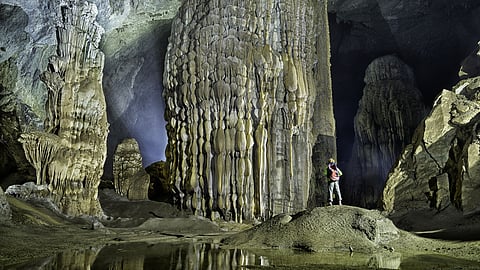
- Destinations
- Experiences
- Stay
- What's new
- Editor’s Picks
- Responsible Tourism
- CampaignsCampaigns
- Subscribe

Vietnam is a traveller’s delight thanks to its diverse landscapes, delicious food, warm and friendly people, and affordability. But did you know that the Southeast Asian nation also has the world’s largest natural cave? Located inside the UNESCO World Heritage Site of Phong Nha-Kẻ Bàng National Park, Hang Sơn Đoòng (“mountain river cave”) is a spectacular natural formation that was shaped by millions of years of erosion. It’s so big that you can fit any of the world’s other largest caves comfortably inside it, as well as several 40-storey skyscrapers.
Here’s all you should know about the Sơn Đoòng cave.
The cave was discovered in the early 1990s by resident Hồ Khanh, who was searching the area for agarwood, a valuable timber. As he approached the entrance of the cave, he noticed clouds billowing out it and could hear the sounds of a river raging from somewhere inside. He decided to move on without further inspection and promptly forgot about it. Years later, he mentioned his discovery in passing to two members of the British Cave Research Association (BCRA), who were exploring the local area. They asked him to attempt to rediscover the entrance, which Khanh eventually managed to do in 2008. In 2009, he led an expedition from the BCRA to the cave entrance.
The ecosystem inside Hang Sơn Đoòng is as unique as it is large, measuring 503m in height, 175m in width and 9.4km in length. Rare limestone cave pearls—which are formed when water droplets from the ceiling fall into rimstone pools on the floor of the cave—are scattered in dried pools, and the largest stalagmite ever found stands 80m tall. Collapsed ceilings have created openings known as dolines, allowing foliage to grow inside the cave. Microscopic organisms thrive in the darkness and wildlife sightings are common, with monkeys, flying foxes, snakes, bats, birds, and endemic species of fish and shrimp finding refuge here.
One of the cave’s largest sections is the Hope and Vision Passage. To reach it, you will have to cross the knee-deep underground river first. Next to the river is a passage imprinted with corals which were fossilised hundreds of million years ago. The passage also has a 17°C-20°C lake in which visitors can swim and relax after a hard trekking day.
Another wonder of the Sơn Đoòng cave is the Passchendaele Passage, a 600m lake below the Great Wall of Vietnam. When the expedition team first approached the area, all of the water in the lake had been drained out, leaving behind a hip-deep muddy passage. The members of the expedition team worked hard to get across it; their efforts reminded them of the Battle of Passchendaele in World War I, which is how the name of the passage came about. When it rains a lot, the water fills up the passage to form a beautiful jade-green lake. Tourists then use rafts or boats to traverse it.
Expeditions to Hang Sơn Đoòng are the exclusive domain of Oxalis Adventure. Their six-day trip costs INR 251,785 (USD 3,000) per person and promises an adventure where participants enjoy the natural beauty and harmony of the more-than-human world. There are presently no bookings for the remainder of 2024 but you can get started on booking one for 2025.
The Tú Làn cave system was woven together by a network of streams that carved up the countryside over millions of years. The result is a collection of caves that are all strikingly different from one another. Inside the limestone mountain area are enormous stalagmites and stalactites, as well as underground rivers and waterfalls. Explorers embarking on a tour of Tú Làn will have to trek through remote jungle, cross through buffalo fields, and plunge into underground rivers that wind through mountains and river valleys alike.
Discovered in 2012 and opened to visitors in 2015, Hang Va’s highlight is a spectacular stalagmite field partly submerged in crystalline waters. The natural formation of a river passage below and a large high-level passage above with dozens of tower cone formations is stunning to look at. There are cones of different sizes and shapes, with the tallest tower cones being around 2m high. Inside the cave, the temperature hovers around 22°C-25°C. Summer is a good time to enjoy swimming inside Hang Va.
This gigantic cave is very close to Hang Sơn Đoòng. Getting here involves a trek through dense jungle, valleys and the Ban Doong minority village, a remote tribal settlement. The highlight of a trek here is camping on a sandy beach beside an emerald pool.
For an alternative way to see Phong Nha, try a kayaking tour away from the crowds. The Dark Cave of Hang Tối is just a few kilometres away and is known for its unique mud cave experience, ziplining, underground river swimming and kayaking adventures.
If caving doesn’t appeal, hiking is a rewarding way to encounter the lush landscape. Local experts will take you along hidden trails unknown to other travellers. Those who love wildlife should consider a night tour or pay a visit to animal rescue centres on a two-day hiking eco-tour.
If you’re an avid cyclist, try taking on the paved roads of the national park—just be sure to have a proper mountain bike, a map and plenty of water on hand. For a more engaging experience, book a cycling tour with local guides who can show you unmapped paths and introduce you to farmers and villagers.
Take a flight from India to Nội Bài International Airport (HAN) in Hanoi or Tân Sơn Nhất International Airport (SGN) in Ho Chi Minh City. Then, take a flight onwards to Đồng Hới Airport (VDH), which is 42km away from Phong Nha-Kẻ Bàng. You can also reach Đồng Hới via the North-South railway line.
